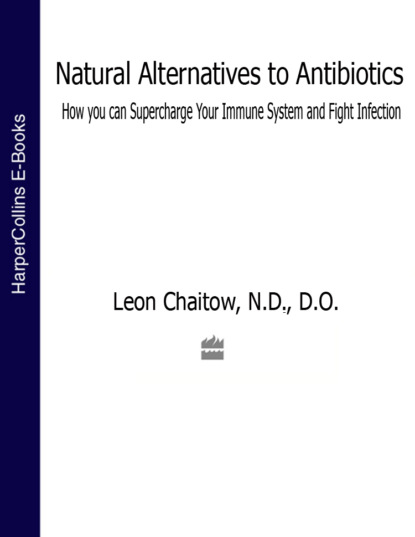По всем вопросам обращайтесь на: info@litportal.ru
(©) 2003-2024.
✖
Natural Alternatives to Antibiotics: How you can Supercharge Your Immune System and Fight Infection
Автор
Год написания книги
2019
Настройки чтения
Размер шрифта
Высота строк
Поля
The laws of natural selection (and survival of the fittest) teach us that when assaulted by a toxic (to them) substance such as an antibiotic, some bacteria will survive, because they already have, or will develop, a natural immunity to the antibiotic. Those bacteria that survive will then be able to transmit this resistance to their descendants – this process lies at the heart of the superbug problem.
Antibiotics
Although there are a few records on the use of substances extracted from various molds to treat infection, going back thousands of years to ancient Egypt and indeed throughout recorded history, the modern era of antibiotic use dates back to around 1940.
PENICILLIN
Fleming had identified the antibiotic penicillin effect in 1929, however it was not until 1941 that extracts of the mold microbe Penicillium notatum were ready for use to treat infection. When enough of the first penicillin had been painstakingly gathered by the early researchers to treat patients, they were faced with the problem of too great a demand and too slow a production, especially after some of the initial cures, which were dramatic and newsworthy.
Conditions such as meningitis, septicemia and pneumonia became controllable for the first time, the early antibiotics proving superior in their effects to the sulfur drugs.
One early method of ‘recycling’ penicillin was to extract traces of it from the patient’s urine and re-use it. After some years, methods of production improved and this recycling was stopped.
Penicillin was initially used widely in childhood infections as well as for serious life-threatening infections in adults.
Penicillin, and all antibiotics, are of no value whatever in treatment of viral illnesses, and yet in the early days through ignorance, and right up to the present, antibiotics were and are regularly prescribed for conditions not caused by bacteria at all.
Allergic reactions to penicillin, as well as other types of reactions (usually mild and short-lived) including diarrhea and nausea, became (and remain) extremely common.
One result of the enthusiastic and excessive use of penicillins was that by the late 1940s many disease-causing organisms had developed resistance to the early versions, and the energies of the pharmaceutical manufacturers were focused on the never-ending job of finding new variations which could control the resistant bacteria. In his prophetic book When Antibiotics Fail, Marc Lappe of the University of Illinois College of Medicine points out that over 23,000 different forms of penicillin had been developed during the period 1975 to 1986 (plus over 7,000 cephalosporins, 1,500 rifamycins, 3,000 tetracyclines, 750 lincomycins, 300 streptomycins and a further 1,000 aminoglycosides!).
The painful truth is that the fortunes of many drug companies depend upon new resistances developing, new drugs appearing, and the cycle continuing forever. The problem for them is that it cannot, as options are increasingly limited in terms of new antibiotics. Other strategies will have to be found to deal with the super-resistance of the superbugs and the health crisis this is causing.
STREPTOMYCIN
By 1944 streptomycin had been developed (from the bacteria Streptomycaes griseus) – a breakthrough as this was able to treat tuberculosis effectively – for a while. It was not long, just a few years, before resistant strains appeared of Mycobacterium tuberculosis.
Streptomycin was also soon found to be extremely toxic and is in decline in usefulness in Western industrialized countries, although in many under-developed countries it is widely and inappropriately used (along with other antibiotics) – often without the need for prescription – causing a potential disease time-bomb in often malnourished populations.
According to the British Medical Association,
These potent drugs are effective against a broad range of bacteria, but they are not as widely used as some other antibiotics because they have to be given by injection, and they also have potentially serious side-effects.
Their use is therefore limited to hospital treatment of serious infections.
Possible adverse effects include:
damage to the nerves of the ear
damage to the kidneys
severe skin rashes.
Over the more than 50 years since penicillin and streptomycin appeared, a host of new antibiotics have emerged and continue to reach the market every year.
CHLORAMPHENICOL
In the late 1940s came the chloramphenicol drugs, a ‘broad-spectrum’ antibiotic which was apparently effective against many different microorganisms. These drugs were originally widely and enthusiastically used to treat everything from gonorrhea to blood infections and gastroenteritis.
Unfortunately however for the manufacturers of chloramphenicol, some extremely serious side-effects soon began to appear – albeit in only a small number of patients – including potentially fatal aplastic anemia. It also caused major problems when used to treat young children, and so chloramphenicol’s use in industrialized nations has now diminished to very special situations only, such as:
typhoid fever (which means that it is still widely used in underdeveloped countries where typhoid is widespread)
some forms of meningitis
life-threatening chest infections
where nothing else is working to control a serious bacterial infection, so that there is little to lose by trying something as potentially dangerous as a form of chloramphenicol.
The irony here is that because chloramphenicol antibiotics are now used so rarely, bacterial resistance has not been developing against them as rapidly, making these highly toxic drugs possible choices if superinfection occurs. This leads to the thought that if the bug doesn’t get you, the treatment just might.
TETRACYCLINES
In the late 1940s, new antibiotics derived from soil microorganisms appeared. These have an even wider target range than the chloramphenicol drugs – and are known as tetracyclines. One of the most popular of the tetracyclines first appeared in 1950 – oxytetracycline, which is still very much in use.
These antibiotics were and are used to treat infections of many sorts, including those of the eyes, ears, throat, digestive and urinary tracts, acne and a number of sexually transmitted diseases. Unfortunately, as with many other antibiotics, tetracyclines are also widely used in agriculture and have entered the food chain.
The excessive and indiscriminate use of these extremely broad-spectrum antibiotics has resulted in bacterial resistance appearing which limits their use – though, given their side-effects, some might consider this a blessing.
Side-effects to tetracycline drugs are numerous according to the British Medical Association, which summarizes them thus:
A major drawback to the use of tetracycline antibiotics in young children and pregnant women is that they can discolour developing teeth. When given by mouth they have to be administered in high doses to reach effective levels in the blood (because they are poorly absorbed through the intestines). Such high doses increase the likelihood of diarrhoea.
Short-term reactions include:
allergic reactions
sore and itchy rectum
sore tongue
swallowing difficulties.
Long-term problems relate to the demolition job that tetracyclines do on the bowel flora, the friendly bacteria which detoxify our intestines and manufacture B-vitamins for us, and above all which keep yeasts under control.
When tetracycline drugs are used, often for months on end to treat acne, for example, an overgrowth of yeast in the bowel is almost certain, and it can take years to put this right. (See Chapters 7 and 8 for details of aspects of these effects and what you can do about them, as well as Chapter 9 for probiotic strategies to help reverse this damage.)
CEPHALOSPORINS
As mentioned above, the cephalosporins (such as cefaclor) were first extracted from fungal spores found in sewage in the mid-1940s. They were initially fairly toxic, but with steady development of more refined versions they have become less so.
Cephalosporins act in similar ways to penicillin-type drugs, have a wide spectrum and are fairly well tolerated. Their use is mainly in treatment of infections of the chest, urinary tract, liver and gall bladder, as well as for gonorrhea. They are commonly being used prophylactically, before surgery for example, and are frequently used when penicillin antibiotics fail to control infection. They can be administered either by mouth or by injection.
Side-effects include:
allergy – relatively common – in up to 10 percent of patients, in the form of rashes, fever and sickness
severe blood clotting problems – relatively rare.









